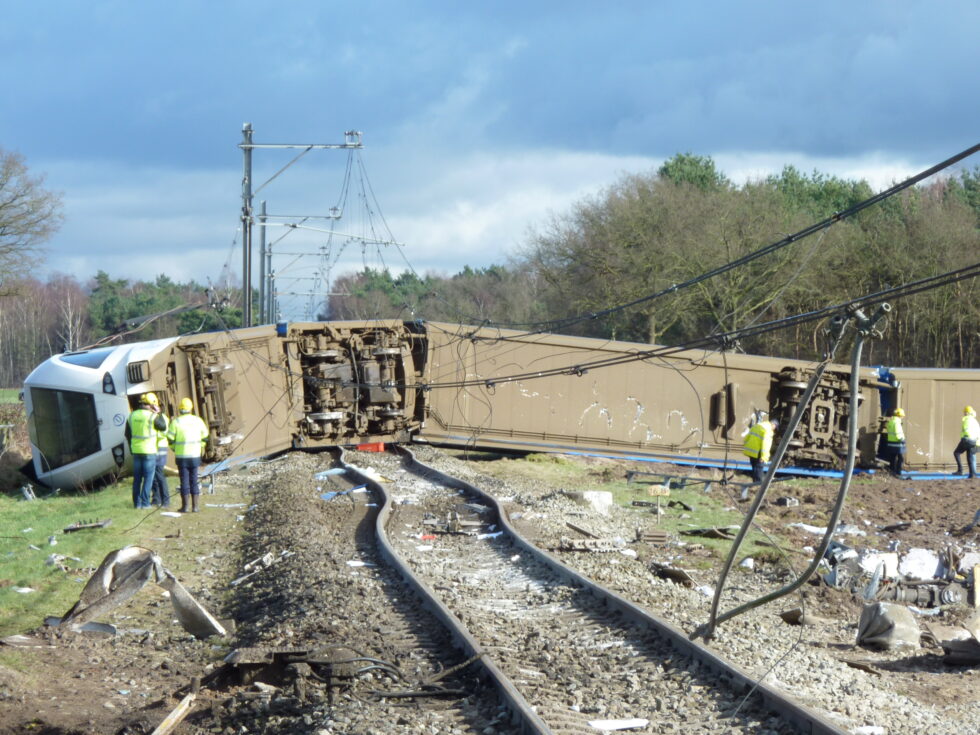
Collision between a passenger train and a man lift at Dalfsen
On 23 February 2016, a passenger train travelling at high speed collided with a man lift crossing a level crossing in Dalfsen. The train driver was killed in the accident. The cab he was in was completely destroyed. The train derailed and ended up on its side. Two people on the train suffered minor injuries. The man lift was completely destroyed.
The number of serious level crossing accidents has decreased significantly in recent decades. This decrease has stagnated in recent years; the number of fatal casualties has stabilised at 10 to 15 per year for some time now. The train collision gave the Dutch Safety Board cause to investigate whether lessons could be learnt for improving level crossing safety in general.
Publication
The man lift’s crossing manoeuvre
Prior to the accident, the landscaping firm had used the man lift involved in the collision to uproot a tree on a plot of land close to the level crossing. An employee of the landscaping firm was driving the man lift, via the level crossing, to the start of the road where the rental company was to collect it with a truck. The level crossing was protected by automatic half barriers. These automatic half barriers had a normal warning time, but the time required for this man lift to cross was approximately three times longer. Those involved believed that the crossing was nevertheless possible, because they assumed that the period between two train passages would be at least ten minutes. One day earlier, when they had made the journey in the opposite direction, this had indeed been the case. However, the return journey took place at a different time of day, when the period was only approximately six minutes, in accordance with the timetable. The accident threat became clear to the man lift operator when he saw that a train was approaching during the crossing manoeuvre. However, avoiding the collision was by then no longer an option.
Train crashworthiness and train driver’s escape options
The fact that the train cab was destroyed was primarily due to the train’s high speed and - to a lesser extent - the large mass and the rigidity of the man lift and its low centre of gravity. The impact of the collision was four times higher than a train must be capable of withstanding according to the current standard for crashworthiness. Moreover, considerable forces were probably exerted on the front of the train again after it collided with the man lift, as a result of crashing into an overhead lines pole and the derailment of the train.
Train crashworthiness and train driver’s escape options
The fact that the train cab was destroyed was primarily due to the train’s high speed and - to a lesser extent - the large mass and the rigidity of the man lift and its low centre of gravity. The impact of the collision was four times higher than a train must be capable of withstanding according to the current standard for crashworthiness. Moreover, considerable forces were probably exerted on the front of the train again after it collided with the man lift, as a result of crashing into an overhead lines pole and the derailment of the train.
The train involved in the accident in Dalfsen is part of a series of 88 trains where the cab crash structure exhibits weld defects. In the collision in Dalfsen, the forces were so great that even a cab without weld defects would have collapsed.
Whether or not the train driver attempted to escape from the cab into the passenger compartment is unclear. What is clear is that the train driver in this accident, just as in similar accidents, did not have sufficient time to be able to complete an escape attempt. Because of several reasons, one of which was that a curve in the track was obscuring his view, the train driver was only able to see the threat of an accident very late (approximately 4½ seconds before the collision).
The standard for crashworthiness needs to be enhanced, because the ability to actually use the escape option cannot be relied upon. When doing so, it is worth noting that the effect of such an enhancement can only be expected in the long term, due to the long service life of trains. The Safety Board believes that safety could be improved in the shorter term by concentrating efforts on preventing high-impact level crossing collisions.
Level crossing safety
The accident in Dalfsen occurred because the man lift did not clear the level crossing in time. More than half of the collisions between passenger trains and motor vehicles have the same cause. Timely clearance is primarily the responsibility of the road user, but they can make errors of judgement (as occurred in Dalfsen) or they can become stranded on the level crossing unexpectedly. No measures have been implemented in the Netherlands to counteract such errors of judgement. Nor can road users alert train traffic if they encounter problems on a level crossing. Both of these possibilities are used in the United Kingdom, for instance.
As was the case in the accident in Dalfsen, level crossing collisions that result in injury to the train occupants usually involve a train approaching at high speed that brakes shortly before the collision and then collides with a heavy road vehicle. The investigation revealed that no account is taken of these factors in the risk assessment of level crossings.





Related news
-
 News:
News:Investigation into derailed train at Dalfsen
- Accident type
- Freight and (agricultural) construction traffic
- ...


